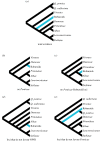A genetic legacy of introgression confounds phylogeny and biogeography in oaks
- PMID: 28515204
- PMCID: PMC5443950
- DOI: 10.1098/rspb.2017.0300
A genetic legacy of introgression confounds phylogeny and biogeography in oaks
Abstract
Oaks (Quercus L.) have long been suspected to hybridize in nature, and widespread genetic exchange between morphologically defined species is well documented in two- to six-species systems, but the phylogenetic consequences of hybridization in oaks have never been demonstrated in a phylogenetically diverse sample. Here, we present phylogenomic analyses of a ca 30 Myr clade that strongly support morphologically defined species and the resolution of novel clades of white oaks; however, historical hybridization across clade boundaries is detectable and, undiagnosed, would obscure the imprint of biogeographic history in the phylogeny. Phylogenetic estimation from restriction-site-associated DNA sequencing data for 156 individuals representing 81 species supports two successive intercontinental disjunctions of white oaks: an early vicariance between the Eurasian and American white oaks, and a second, independent radiation represented by two relictual species. A suite of subsampled and partitioned analyses, however, supports a more recent divergence of the Eurasian white oaks from within the American white oaks and suggests that historic introgression between the Eurasian white oaks and a now-relictual lineage biases concatenated phylogenetic estimates. We demonstrate how divergence and reticulation both influence our understanding of the timing and nature of diversification and global colonization in these ecologically and economically important taxa.
Keywords: Quercus; RADseq; hybridization.
© 2017 The Author(s).
Conflict of interest statement
We declare we have no competing interests.
Figures



References
-
- Soltis DE, Mavrodiev EV, Doyle JJ, Rauscher J, Soltis PS. 2008. ITS and ETS sequence data and phylogeny reconstruction in allopolyploids and hybrids. Syst. Bot. 33, 7–20. (10.1600/036364408783887401) - DOI
MeSH terms
LinkOut - more resources
Full Text Sources
Other Literature Sources
